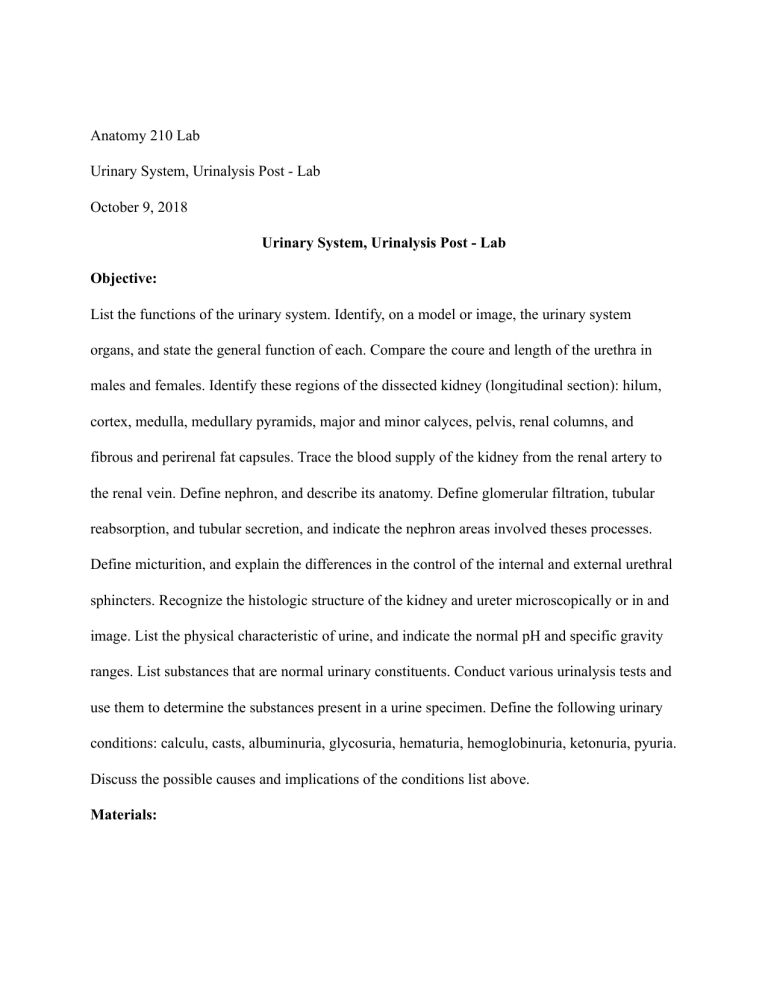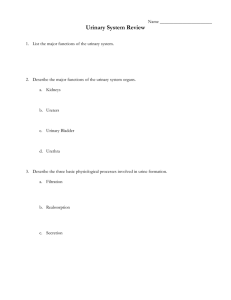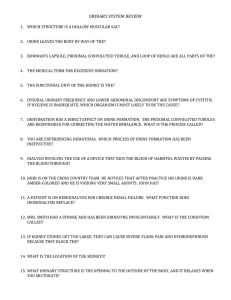
Anatomy 210 Lab Urinary System, Urinalysis Post - Lab October 9, 2018 Urinary System, Urinalysis Post - Lab Objective: List the functions of the urinary system. Identify, on a model or image, the urinary system organs, and state the general function of each. Compare the coure and length of the urethra in males and females. Identify these regions of the dissected kidney (longitudinal section): hilum, cortex, medulla, medullary pyramids, major and minor calyces, pelvis, renal columns, and fibrous and perirenal fat capsules. Trace the blood supply of the kidney from the renal artery to the renal vein. Define nephron, and describe its anatomy. Define glomerular filtration, tubular reabsorption, and tubular secretion, and indicate the nephron areas involved theses processes. Define micturition, and explain the differences in the control of the internal and external urethral sphincters. Recognize the histologic structure of the kidney and ureter microscopically or in and image. List the physical characteristic of urine, and indicate the normal pH and specific gravity ranges. List substances that are normal urinary constituents. Conduct various urinalysis tests and use them to determine the substances present in a urine specimen. Define the following urinary conditions: calculu, casts, albuminuria, glycosuria, hematuria, hemoglobinuria, ketonuria, pyuria. Discuss the possible causes and implications of the conditions list above. Materials: ● Human dissectible torso model, three - dimensional model of the urinary system, and/ or anatomical chart of the human urinary system. ● Dissecting instruments and tray ● Three- dimensional models of cut kidney and of a nephron ● Compound microscope ● Prepared slides of a longitudinal section of kidney and cross sections of the bladder ● Post - it ● Disposable Gloves ● Student urine samples collected at the beginning of the lab, or normal artificial urine provided by the instructor. ● Numbered pathological urine specimens provided by the instructor ● Wide - range pH paper ● Dipsticks:individual (Clinisix, Ketosticx, Albustix, Hemastix) ● Urinometer ● Test Tubes, test tube rack, and test tube holders ● 10 -cc graduated cylinders Procedure: Activity 1 - Identifying Urinary System Organs Activity 2 - Studying Nephron structure Activity 3 - Studying Bladder structure Activity 1 - Analyzing Urine Sample Activity 2 - Analyzing Urine Sediment Microscopically Result:






